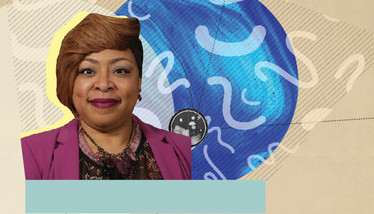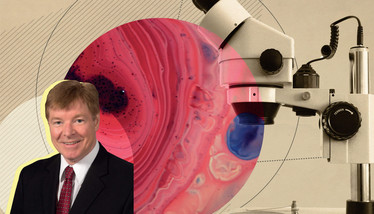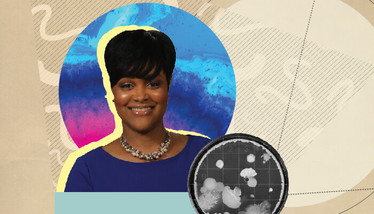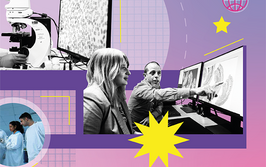
The Dream of Diversity
Increasing the African-American presence in pathology
Angelina Knott, Robin Suggs, and Timothy Craig Allen | | Longer Read
“… who makes friends with black males in today’s world?” — Gregory A. Threatte (1)
Diversity versus inclusion
Pathology has long been a diverse profession – but is “diversity” really enough? In our opinion: no. We must strive to be not only diverse, but also inclusive. Inclusion, “[f]ully and respectfully involving all members, regardless of gender, religion, race, color, sexual orientation, national origin, age, or physical ability, in the activities and life of the organization (2),” fulfills the promise of diversity. Diversity – for example, with respect to issues related to people of color – provides for proactive retention and recruitment efforts, ensures some representation at all levels, and addresses differentiation between groups. In contrast, inclusion actualizes diversity; it calls for critical mass at all levels, the inclusion of people of multiracial identity, and two-way mentoring across racial lines (3). “The challenges are to broaden the definition of diversity to include all social identity groups, to understand that an inclusive culture for all members of the organization is a must and to convey the links between leveraging diversity, a culture of inclusion, and organizational success (4).”
In an article on diversity and inclusion in medical schools, Jennifer Tsai said, “Hospitals and medical schools are training their eyes on the numbers. But these institutions focus so much on the quantitative proof of diversity that they’re missing their failures to safeguard inclusion (5).” And yet, all is not lost. Pathologists can assist in the quest for inclusion – not least because we are, and have been for many decades, a strongly diverse profession.

Robin Suggs
But although pathology currently has measurable diversity, it doesn’t reflect the community. African-Americans are historically underrepresented in medicine (in fact, in 2015, African-Americans represented just 6 percent of medical school graduates, a number unchanged over at least four years [6]). The same population is markedly underrepresented in pathology to the point where one African-American pathologist, prominent on social media, has described herself as “almost a unicorn (7).” It is ironic that, although the Constitutional amendment and federal laws governing diversity and the United States Supreme Court decisions interpreting them, come from situations involving African-Americans, pathology still has so little African-American representation. Our discipline will never be able to proudly claim it has complete diversity and inclusion without an African-American pathologist presence that reflects the community.
Increasing the presence of this population in pathology cannot be done easily or quickly. “If all reasonably possible outreach is undertaken and the pool of applicants with the potential to be interviewed do not include minorities and women, then it is reasonable to conclude that there is likely a significant deficit of qualified and available minorities and women (i.e., a severe ‘pipeline problem’)… (8).” Unfortunately, the problem is not limited to pathology; medicine as a whole has far too few minorities in its pipeline, and African-Americans are hit particularly hard.
Why is there a pipeline problem?
Growing up in rural America is rooted in traditions. Historically, African-American families have raised their children to do what is safe and trusted. In their communities, it truly takes a village to raise a child. But all too frequently, opportunities aren’t communicated – or may even be thought of as “not fitting” for an African-American child. In such an environment, families recommend that their children choose careers they think are achievable and will provide a stable, reasonable wage. Rural African-American children are frequently raised to seek jobs that will make them “honest, hardworking people.” It is also considered important to find a career that doesn’t require a long training period – ensuring that it will quickly provide a source of income as an adult.
These careers – teaching, nursing, military service – are certainly laudable, but the self-imposed glass ceiling remains. African-American families in rural America rarely recommend that their children consider becoming physicians, and certainly not pathologists. Generally, neither do teachers and counselors. Schools perpetuate the “safe” options through Career Days and choice sheets. Being a doctor is the dream reserved for well-to-do families, often ones in which there are already physicians. And for many African-American children, the battle is even harder: they often attend underperforming schools and deal with multiple negative socioeconomic determinants. Some may even be completely unaware of the medical profession, much less believe that they themselves would be capable of succeeding in it.

Timothy Craig Allen
A head start on a solution
We believe that success will require pathologists’ lifetime mentoring of young African-Americans who have been identified as talented. In particular, we are starting to work with fourth-graders: nine- and ten-year-old children. Many of these children have never experienced the kinds of opportunities we take for granted, and know little about medicine (and certainly nothing of pathology). We need to go to them and talk directly to them – but we also need to be careful how that outreach occurs. It’s neither right nor effective to simply visit these children’s communities, load them down with facts, and then leave. Rather, pathologists need to partner with African-American men and women – existing members of those communities – to build bridges to those fourth-graders. Local community leaders (clergy, school guidance counselors, teachers, principals) could connect pathologists to the children we want to reach.
But even working with those bridging members falls short of the ideal. What we need more than anything else is African-American role models – pathologists that a child can say “look like me.” These pathologists could mentor multiple children through an occasional telepresence, while others (not necessarily of the same race) could develop a lifetime mentoring relationship that will serve the student through high school, college, medical school, residency, and beyond. Strong and consistent mentorship from an early age can provide support, guidance, and transformational opportunities for African-Americans in medicine, ultimately decreasing the current stark deficit of qualified and available minority medical school applicants, doctors, and pathologists.
The African-American community has always embraced the philosophy that “it takes a village to raise a child.” For pathologist mentors to be successful, they need to adopt that philosophy as well. To guide these students – and ultimately produce great pathologists – not only they, but also their communities, must be supported. Understandably, African-American children may want to see a pathologist who “looks like them” to prove that they could actually realize the dream of a medical career – but the involvement of those pathologists does not diminish the importance of the responsibility we all share for mentoring those children through the process of obtaining a medical degree and beyond. When we communicate this new career option to the parents of fourth-graders, we have to include a clear outline of the mentoring relationships we hope will last a lifetime. And once these programs are in place and the benefits begin to show, I think that other schools and communities will want to become a part of this endeavor.
Facing the obstacles
There is likely to be pushback. Some believe that “enough” has already been done to help African-Americans – but that belief ignores the reality of many African-American families. For example, a housekeeper at our institution recently shared that her daughter was graduating from high school. She reminisced that, when young, her daughter would “joke” about becoming a doctor one day. Whether or not the child meant it sincerely, the housekeeper did not support that dream or motivate her daughter because she didn’t believe it was possible; she thought there would be too many obstacles to overcome. In her words, “They’ll never let her make it.” This lady wanted the best for her child – but, at the same time, she was unwittingly imposing her own childhood experiences upon her daughter and thereby limiting her.

Angelina Knott
Today, “they” are not going to keep a child from making it; “they” no longer exist. But “their” ghost hovers in African-American parents’ memories, influencing their children’s choices. Imagine a child who has no dreams because he harbors no hope. Or a child who dreams, but sees no way those dreams can ever become a reality. Or one who dreams, only to be told, “You can’t do that.” Imagine the staggering loss of potential. And that’s why early mentorship is so important – because it can expand the horizons of young African-Americans in a strategic and targeted way before their paths are set in stone.
And it’s pathologists themselves who are the key to expanding those horizons. We must understand these perspectives if we are to help African-American children find their way to pathology. We need to engage with them and support their excitement in pursuing this new, precious career option – being a pathologist! It’s a responsibility that will require extraordinary, lifelong dedication, but it is an opportunity that pathologists – innately caring physicians – should relish.
“… as a physician, a professor, and/or a director, you are of unquestioned authority to most young people. Believing in someone, before they have had a chance to believe in themselves, can be decisively important; not just to them as individuals, but to us as a society (1).”
“… everyone should find a young black [child], make a friend, and then believe in them…” — Gregory A. Threatte (1)
- GA Threatte, “Black males in medicine: my view”, Acad Pathol, 3, 2374289515624702 (2016). PMID: 28725756.
- FA Miller, JH Katz, “Glossary”, The Inclusion Breakthrough: Unleashing the Real Power of Diversity, 199. Berrett Koehler: 2002.
- FA Miller, JH Katz, “Chapter 4: Enabling Policies and Practices”, The Inclusion Breakthrough: Unleashing the Real Power of Diversity, 82–83. Berrett Koehler: 2002.
- FA Miller, JH Katz, “Chapter 2: Positioning for Radical Change”, The Inclusion Breakthrough: Unleashing the Real Power of Diversity, 26. Berrett Koehler: 2002.
- J Tsai, “Diversity and inclusion in medical schools: the reality” (2018). Available at: bit.ly/2LfMhl9. Accessed September 5, 2018.
- The Association of American Medical Colleges, “Diversity in Medical Education: Facts and Figures 2016” (2016). Available at: bit.ly/2NNc999. Accessed September 5, 2018.
- V Fitzhugh (2018). Available at: bit.ly/2Q3te0l. Accessed September 5, 2018.
- American Association for the Advancement of Science, “Handbook on Diversity and the Law: Navigating a Complex Landscape to Foster Greater Faculty and Student Diversity in Higher Education” (2010). Available at: bit.ly/2wOkxia. Accessed September 5, 2018.
Angelina Knott is Department Business Administrator of the Department of Pathology at the University of Mississippi Medical Center, Jackson, USA.
Robin Suggs is Project Manager II of the Department of Pathology at the University of Mississippi Medical Center, Jackson, USA.
Timothy Craig Allen is Professor and Chair of the Department of Pathology at The University of Mississippi Medical Center, Jackson, USA.




















